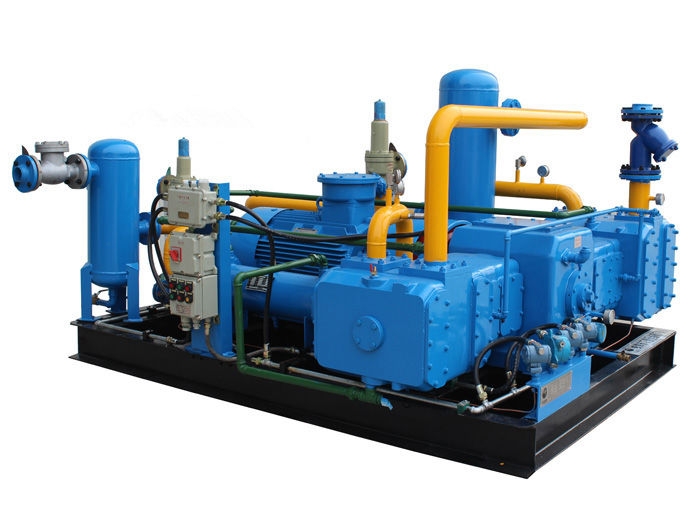The Potential of Compressing Methane Gas: A Green Solution for Energy
What is meant by methane gas compressing?
- Applying pressure on methane gas to reduce its volume is known as compression. Carbon and hydrogen atoms are the main components of the natural gas known as methane. The amount of space methane gas takes up is reduced as it is compressed because the molecules are brought closer together. The gas is frequently compressed to make the storage, transportation, and use of methane gas easier. Methane may be compressed into smaller containers and moved more effectively through pipelines or CNG cylinders. Compressed natural gas is frequently used as a fuel for power production, heating, and transportation.
- The methane gas’s pressure is raised throughout the compression process using compressors. More gas can be kept in a given volume due to its increased density when compressed. Depending on the individual use and the demands of the storage or transit system, methane gas is compressed at a certain pressure. It’s crucial to remember that compressing methane gas calls for the right tools and safety precautions. Compression systems must be constructed and operated with the proper care since methane is a combustible and potentially dangerous gas, ensuring safe handling and use.
Unlocking the Potential of a Sustainable Process for Compressing Methane Gas:
The main element of natural gas is methane, a powerful greenhouse gas. Finding ways to use methane’s potential as a cleaner and more sustainable energy source is of growing importance as worries about climate change and the need for sustainable energy sources rise. Compressing methane gas, which may be used in numerous ways to harness its potential, is one method of doing this.
Energy Storage:
Methane compression enables effective energy storage. Methane has the ability to be compressed at high pressures, greatly lowering its volume. The compressed methane can then be kept in tanks or subterranean facilities where it can act as a dependable energy source that can be used as necessary. This makes it a practical choice for balancing erratic renewable energy sources like wind and solar energy, which frequently need backup energy storage options.
Transportation:
CNG, or compressed natural gas, is becoming a more popular alternative fuel for cars. Methane may be stored in CNG cylinders onboard automobiles by being compressed to high pressure, making it an energy-dense and cleaner-burning fuel source. CNG-powered vehicles emit fewer pollutants than conventional petrol or diesel-powered vehicles, improving air quality and lowering their carbon impact.
Distributed Energy Generation:
Compressed methane can also be used for decentralized or distributed energy production. Small-scale compression facilities may be built in several places, enabling the use of methane to generate power and heat. In places with limited access to conventional power grids, these distributed energy systems can be very helpful for fostering energy independence and sustainability.
Methane as a Chemical Feedstock:
Compressed methane is a useful raw material for the synthesis of several different compounds. The main raw material used to create hydrogen, which may then be used in fuel cells or as a source of clean energy, is methane. Additionally, using procedures like steam reforming or methanation, methane may be transformed into other useful products, including methanol or synthetic natural gas. These conversion routes provide chances to use methane more sustainably, lowering dependency on fossil fuels.

A Game-Changer in Energy Storage: The Marvel of Methane Gas Compression:
Methane gas compression has been acknowledged as a game-changer for energy storage. Due to its availability, affordability, and clean-burning characteristics, methane, the main component of natural gas, has emerged as a promising candidate for energy storage. Let’s look at how the compression of methane gas is changing how energy is stored.
- High Energy Density:
Due to its high energy density, methane gas can store a substantial quantity of energy in a comparatively small space. The amount of methane gas is significantly reduced when compressed; making underground storage facilities or above-ground tanks an effective storage option.
- Existing Infrastructure:
Methane gas may be compressed and stored using the current natural gas infrastructure. Incorporating methane gas storage into the energy grid is simpler because of this infrastructure, which consists of pipelines, storage facilities, and distribution networks. Because the infrastructure is already in place, this benefit removes the requirement for significant infrastructure investments.
- Flexibility and dispatch ability:
Methane gas compression gives the energy system flexibility and dispatch ability. Methane gas may be easily dispatched as needed, unlike other energy storage types, enabling quick responses to changes in electricity demand. This adaptability is crucial for facilitating the grid’s incorporation of sporadic renewable energy sources.
- Long Duration Storage:
Methane gas compression makes it possible to store energy for a long time, which is necessary for balancing seasonal changes in energy supply and demand. It is now feasible to close the gap between renewable energy generation and consumption during low production by storing compressed methane gas for lengthy periods.
- Renewable Methane:
Compression of methane gas can also aid in the creation of renewable methane. This entails gathering methane emissions from wastewater treatment facilities and compressing and storing the gas. Further lowering greenhouse gas emissions, renewable methane can be used as a carbon-neutral or low-carbon substitute for conventional natural gas.
Conclusion:
Because of its high energy density and affordable price, compressing methane gas is a viable method for storing energy. The pressure and temperature of the gas may be raised for this procedure using a compressor. It is thus possible to store compressed methane gas in tanks or cylinders, frequently used as fuel for electric power production, heating systems, and cars. We can provide any client globally with full one-stop solutions, and we promise that every customer will receive high-quality products and outstanding customer service. HUAYAN provide a knowledgeable advice and a superior product. To lower all costs for our customers, to lower all costs for customers.
